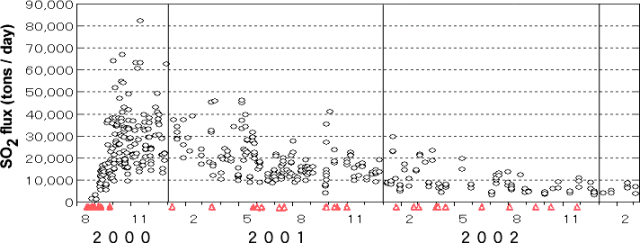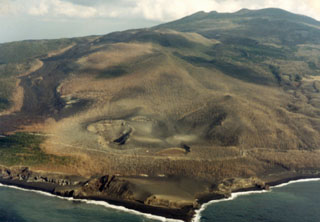Report on Miyakejima (Japan) — April 2003
Bulletin of the Global Volcanism Network, vol. 28, no. 4 (April 2003)
Managing Editor: Edward Venzke.
Miyakejima (Japan) Small explosion in November 2002; continued high SO2 flux through April 2003
Please cite this report as:
Global Volcanism Program, 2003. Report on Miyakejima (Japan) (Venzke, E., ed.). Bulletin of the Global Volcanism Network, 28:4. Smithsonian Institution. https://doi.org/10.5479/si.GVP.BGVN200304-284040
Miyakejima
Japan
34.094°N, 139.526°E; summit elev. 775 m
All times are local (unless otherwise noted)
Miyake-jima has remained restless since the eruption that began in June 2000 (BGVN 25:05-25:07, 25:09, 26:02, 27:03, and 27:11). Small explosions with minor ash emission have been common (see BGVN 27:11). The most recent event reported by the Japan Meteorological Agency was at about 1320 on 24 November 2002, with the plume rising to an unknown height. The SO2 gas output remained high, ~4,000-9,000 tons/day, as of March 2003 (figure 19). Robust degassing was ongoing through the week of 16-22 April 2003. All residents on Miyake-jima island have been evacuated since September 2000, after which time SO2 fluxes reached extremely high values (over 80,000 tons/day in October 2000).
 |
Figure 19. SO2 flux at Miyake-jima during August 2000-March 2003. Triangles along the timeline indicate explosions. Courtesy of the Geological Survey of Japan and the Japan Meteorological Agency. |
Geological Summary. The circular, 8-km-wide island of Miyakejima forms a low-angle stratovolcano that rises about 1,100 m from the sea floor in the northern Izu Islands about 200 km SSW of Tokyo. The basaltic volcano is truncated by small summit calderas, one of which, 3.5 km wide, was formed during a major eruption about 2,500 years ago. Numerous craters and vents, including maars near the coast and radially oriented fissure vents, are present on the flanks. Frequent eruptions have been recorded since 1085 CE at vents ranging from the summit to below sea level, causing much damage on this small populated island. After a three-century-long hiatus ending in 1469 CE, activity has been dominated by flank fissure eruptions sometimes accompanied by minor summit eruptions. A 1.6-km-wide summit crater was slowly formed by subsidence during an eruption in 2000.
Information Contacts: Akihiko Tomiya, Geological Survey of Japan, AIST, 1-1 Higashi, 1-Chome Tsukuba, Ibaraki 305-8567, Japan (URL: http://staff.aist.go.jp/a.tomiya/tomiyae.html); Japan Meteorological Agency (JMA), Fukuoka, Japan (URL: http://www.jma.go.jp/).

